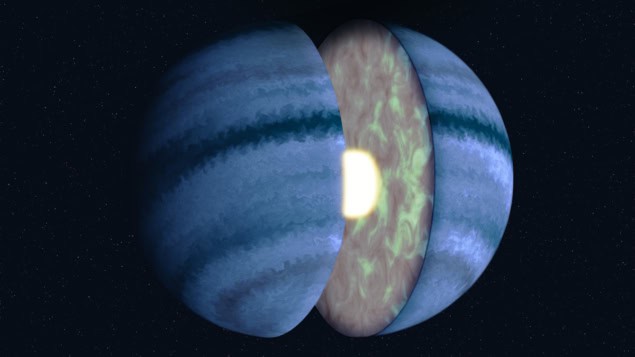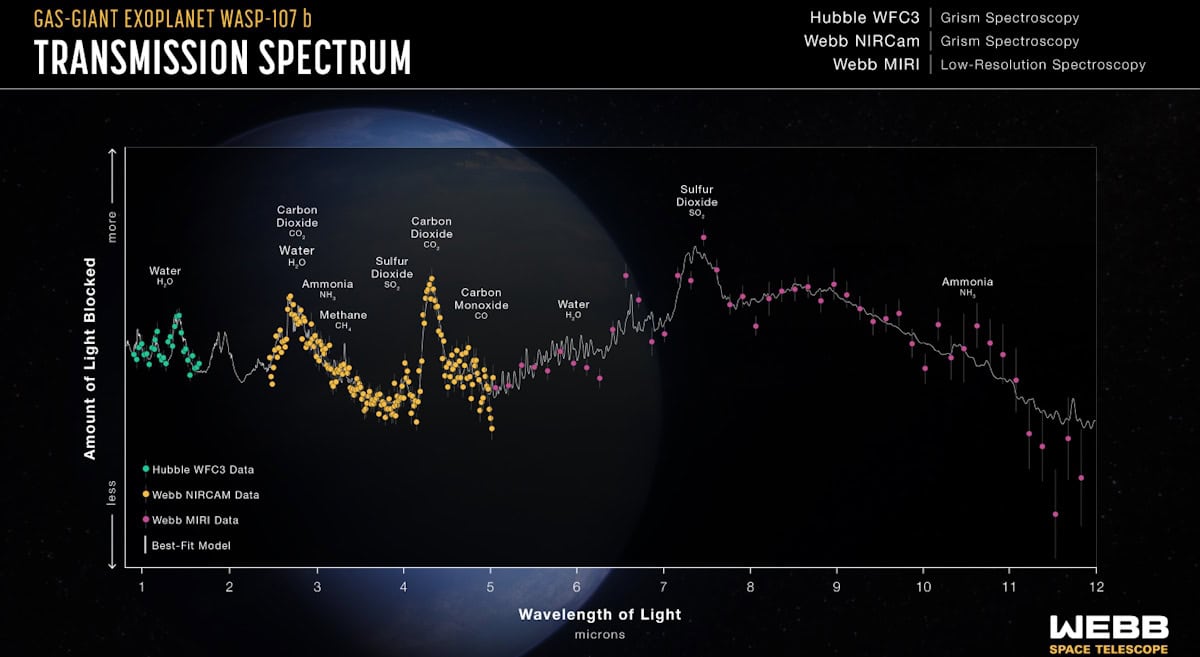
With a puffy structure rather like candy floss, WASP-107 b is a giant exoplanet 200 light-years away from Earth in the constellation Virgo. Almost as big as Jupiter, but less than one-tenth the mass, it is one of the least dense exoplanets known.
But two independent teams of researchers have now had some other surprises. After analysing spectral data from NASA’s James Webb Space Telescope (JWST), they discovered that WASP-107 b has far less methane, is much hotter and has a much bigger core than previously thought.
In the first study, led by David Sing from Johns Hopkins University, the researchers analysed the transmission spectrum of WASP-107 b from the JWST’s Near-Infrared Spectrograph (NIRSpec). They found that the planet’s methane levels were a thousand times lower than expected.
The measurements, reported in Nature, suggest that methane transforms into other compounds as it flows upward from the planet’s interior and interacts with other chemicals and starlight in the upper atmosphere.
The researchers propose that it’s the planet’s hot core driving this strong, convective mixing, with hot gas from deep in the planet mixing vigorously with cooler layers higher up and causing the chemistry of the gases to change. Indeed, the NIRSpec data also revealed the presence of sulphur dioxide, water vapour, carbon dioxide and carbon monoxide.
The findings represent the clearest connection that scientists have been able to make about the interior of an exoplanet and the top of its atmosphere, the researchers say.
“Looking into the interior of a planet hundreds of light-years away sounds almost impossible, but when you know the mass, radius, atmospheric composition, and hotness of its interior, you’ve got all the pieces you need to get an idea of what’s inside and how heavy that core is,” says Sing in a press statement.

In a parallel study, also published in Nature, a team headed up by Luis Welbanks from Arizona State University (ASU) combined observations from the JWST’s Near-Infrared Camera and Mid-Infrared Instrument with those from Hubble’s Wide Field Camera 3. As found in Sing’s study, the researchers measured surprisingly little methane in the atmosphere of WASP-107 b, indicating that the interior of the planet is significantly hotter than originally thought.
They attribute the unexpected high temperature to a process called tidal heating. Here, the planet’s slightly elliptical 5.7-day orbit results in a continuously changing gravitational pull, which physically distorts the planet and heats it up.
The spectra also enabled the researchers to estimate the size of the planet’s core. Using the energy in the planet and the ratio of heavier elements (carbon, nitrogen, oxygen and sulphur) to hydrogen and helium, they calculated the core mass, finding it to be at least twice as massive as originally estimated.

‘Super-puff’ exoplanets put a ring on it
Together, the data suggest that WASP-107 b comprises a relatively large core surrounded by a relatively small mass of hydrogen and helium gas inflated by tidal heating of the interior. The findings help solve the mystery of the planet’s unusual structure – puffy planets are not uncommon, but WASP-107 b is significantly cooler and more Neptune-like in mass than most other low-density planets studied.
“The Webb data tell us that planets like WASP-107 b didn’t have to form in some odd way with a super small core and a huge gassy envelope,” explained ASU’s Michael Line. “Instead, we can take something more like Neptune, with a lot of rock and not as much gas, just dial up the temperature, and poof it up to look the way it does.”
- SEO Powered Content & PR Distribution. Get Amplified Today.
- PlatoData.Network Vertical Generative Ai. Empower Yourself. Access Here.
- PlatoAiStream. Web3 Intelligence. Knowledge Amplified. Access Here.
- PlatoESG. Carbon, CleanTech, Energy, Environment, Solar, Waste Management. Access Here.
- PlatoHealth. Biotech and Clinical Trials Intelligence. Access Here.
- Source: https://physicsworld.com/a/jwst-data-reveal-interior-structure-of-puffy-exoplanet/



